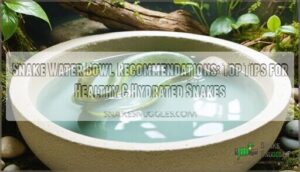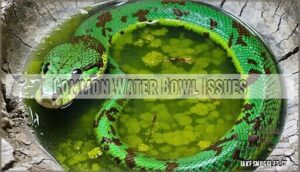This site is supported by our readers. We may earn a commission, at no cost to you, if you purchase through links.

A heavy ceramic or sturdy plastic bowl works great since it’s less likely to tip over—nobody wants a soggy snake.
Pick something large enough for soaking but shallow enough to prevent drowning.
Avoid porous materials like wood; they trap bacteria.
Clean the bowl regularly with reptile-safe disinfectants to keep your snake safe from germs.
Pro tip: Place the bowl on the cool side of the enclosure to reduce evaporation.
Curious how water bowls impact shedding and health?
There’s more to explore on that topic!
Table Of Contents
- Key Takeaways
- Choosing Water Bowls
- Snake Hydration Needs
- Creating Hydrating Environments
- Water Bowl Maintenance
- Common Water Bowl Issues
- Frequently Asked Questions (FAQs)
- What is the best water for snakes to drink?
- How big should a snakes water bowl be?
- How often should you change a snakes water bowl?
- Do corn snakes need a water bowl?
- What happens if a snake knocks over a water bowl?
- What is the best tank for a corn snake?
- What are the best feeder bowls for reptiles?
- Do Reptiles need water bowls?
- What should I do if my snake is curled up?
- What to use for a snake water bowl?
- Conclusion
Key Takeaways
- Choose a sturdy bowl made of safe, non-porous materials to prevent spills and bacterial growth.
- Clean the bowl daily with hot water and disinfect weekly to keep things fresh and germ-free.
- Pick a bowl size that’s big enough for soaking but shallow enough for safety, especially for smaller snakes.
- Place the water bowl on the cool side of the enclosure to reduce evaporation and maintain consistent humidity.
Choosing Water Bowls
When choosing a water bowl for your snake, look for something that’s sturdy, easy to clean, and won’t tip over.
Avoid bowls that are too deep or unstable, as they can create messes or stress your snake.
Ideal Water Bowl Features
The perfect reptile water bowl combines practicality with smart design.
Look for these must-have features:
- Material Durability: Sturdy enough to resist cracks or breaks.
- Cleaning Ease: Smooth interiors simplify scrubbing.
- Tipping Prevention: Heavyweight bowls stay put.
- Size Appropriateness: Big enough for soaking, but not too deep.
- Aesthetic Integration: Blends naturally into enclosures.
A snake water bowl should balance function and style effortlessly!
Many owners purchase necessary supplies online.
Materials to Avoid for Water Bowls
Avoid water bowl materials that can harm your snake.
Porous materials like unglazed ceramic bowls are bacteria magnets.
It’s important to reflect on ceramic safety concerns when choosing a water bowl.
Toxic plastics or plastic bowls with sharp edges may leach dangerous chemicals.
Soft metals such as aluminum can also risk contamination.
Instead, choose water bowl materials that are durable, smooth, and non-toxic to guarantee your snake stays safe and hydrated!
Size and Shape Considerations
Choosing the right water bowl size and shape matters.
Make certain the bowl depth suits your snake’s size—shallow for hatchlings, deeper for adults.
A larger bowl allows soaking during shedding while preventing spillage.
Compact options fit snug enclosures, while wide, stable bases stop tipping.
Shape flexibility depends on space—round or rectangular works, just prioritize function over fancy designs, and ensure the bowl is suitable for your snake’s needs, considering space.
Tips for Selecting The Best Water Bowl
Think about material safety, water bowl stability, and cleaning ease.
A bowl that’s heavy won’t tip, keeping your snake’s water where it belongs.
Match the water bowl size to your snake—bigger snakes need room to soak.
Consider how humidity regulation helps with shedding and respiratory health.
For added charm, pick one with aesthetic appeal that blends with your setup.
Thoughtful snake water bowl recommendations protect snake hydration and health.
Snake Hydration Needs
Your snake needs fresh, clean water every day to stay healthy and hydrated.
Fresh water daily is essential for your snake’s health—hydration fuels digestion, shedding, and overall well-being.
Proper hydration helps with digestion, shedding, and even keeping their body temperature in check, so don’t skip this essential step!
Physiological Needs and Requirements
Snake hydration is essential for healthy digestion, smooth shedding hydration, and overall snake health.
Snakes rely on water quality and proper thermoregulation needs to thrive. A shallow yet adequate water bowl depth supports their drinking behavior without overwhelming them.
Meeting basic snake water needs through consistent care guarantees their reptile hydration stays on track. Optimal humidity levels are also essential for their well-being, and can be found at Optimal humidity levels.
It’s simple and effective, ensuring their well-being through proper care.
Importance of Water for Digestion
Water plays a starring role in your snake’s digestion! Without proper hydration, enzymes can’t break down food, leading to nutrient absorption issues.
A fresh, accessible water source supports waste elimination and overall snake health.
- Refill water bowls daily to guarantee hydration.
- Choose a sturdy bowl to prevent spills.
- Place bowls in low-traffic areas for stress-free drinking.
- Monitor for contamination regularly.
Role of Hydration in Shedding and Skin Health
Keeping your snake hydrated is essential for smooth shedding and maintaining skin elasticity.
Without enough water, shedding difficulties—like stuck skin or scales—can arise, leading to health problems like dysecdysis.
A clean water dish offers essential hydration, preventing dry, flaky skin.
Check hydration indicators, like a snake’s vibrant scales.
Regular snake water bowl maintenance avoids bacteria buildup, safeguarding overall scale health and ensuring smooth shedding.
Effects of Hydration on Temperature Regulation
Your snake’s hydration helps with thermoregulation, keeping it comfy in changing temps.
Snakes use water for evaporative cooling and to avoid dehydration risks.
Here’s how to boost hydration:
- Use shallow, stable snake water dishes for soaking needs.
- Keep a full, clean bowl for frequent access.
- Adjust placement based on species differences.
- Regularly check water during behavioral thermoregulation habits.
Creating Hydrating Environments
You can create a comfortable, hydrating space for your snake by focusing on humidity, temperature, and moisture.
Simple additions like a shallow soaking dish, humidity hides, or misting can keep them happy and hydrated.
Maintaining Optimal Humidity and Temperature Gradients
To keep your snake happy, balance humidity and temperature gradients across its enclosure.
Proper gradient importance lets your pet move between microclimates it prefers.
Well-placed water bowls help with humidity control through evaporation.
Monitor daily with tools or simple thermometers, and tweak seasonal adjustments as needed.
A clean, organized setup guarantees comfort during shedding and stable evaporation rates for health.
Choosing Moisture-Retentive Substrates
Moisture-retentive substrates help maintain healthy humidity control in your snake enclosure.
Choose options like:
- Coconut Fiber: Expands with water, retains moisture well, and suits most snake species.
- Cypress Mulch: Great for bioactive substrates and mold prevention.
- Sphagnum Peat Moss: Perfect for high-humidity needs during snake shedding.
Match substrate composition to your reptile’s needs for ideal health! Consider bioactive substrate ingredients like coco coir and leaf litter for a nutrient-rich base.
Creating Humidity Hides and Misting Regularly
Boost humidity by creating cozy hides with moss or damp paper towels. Misting frequency matters—do it daily for shedding success and respiratory health.
Monitor humidity with a hygrometer to guarantee a healthy range. Many keepers find that humidity helps snakes feel more secure.
| Hide Materials | Benefits |
|---|---|
| Sphagnum Moss | High moisture retention |
| Coco Fiber | Gentle on snakes |
| Damp Towels | Cheap and effective |
| Plastic Boxes | Easy to clean |
Reptile care starts here with complete concepts of snake care, including the use of hide materials and maintaining the right humidity levels for shedding success and overall health.
Offering a Shallow Water Dish for Soaking
A shallow water dish is perfect for reptile soaking, especially during shedding.
Match water bowl depth to snake size—too deep can overwhelm them.
Use a reptile water bowl made of easy-to-clean, safe materials to prevent bacteria.
Clean often, at least weekly, to keep things fresh.
Soaking benefits include better hydration and skin health, making cleaning frequency key!
Water Bowl Maintenance
Keeping your snake’s water bowl clean isn’t just about good looks—it’s essential for their health.
Regular cleaning, fresh water, and a little effort on your part can prevent bacteria buildup and keep your scaly friend happy and hydrated.
Cleaning and Disinfecting The Water Bowl
A clean water bowl means a healthier snake. Rinse daily with hot water to keep things fresh, but don’t stop there.
Dishwashing weekly removes biofilm and residue. Use safe disinfectants like vinegar or reptile sanitization sprays.
- Scrub regularly for stubborn buildup.
- Avoid harsh chemicals that leave residues.
- Inspect for slime—slime equals trouble for snake hygiene!
Changing The Water Frequency
Water bowl cleanliness matters more than you’d think.
Changing water daily prevents stagnant water, keeps bacteria at bay, and supports your snake’s shedding cycle.
Snake activity, like soaking or drinking, affects how often you should refill, and environmental factors, like warm enclosures, may speed evaporation.
Stay consistent with daily refills to maintain proper water bowl maintenance and meet your snake’s hydration needs, ensuring daily refills are a priority to prevent stagnant water.
Monitoring Temperature and Humidity Levels
Think of your snake’s enclosure like a mini ecosystem.
Proper sensor placement guarantees accurate humidity control and thermostat calibration.
Use data logging or remote monitoring for real-time reptile health insights.
Regularly check readings to keep water quality high.
A stable, healthy environment helps maintain water cleanliness and keeps your snake content.
Technology makes monitoring a breeze—no guesswork needed!
Common Water Bowl Issues
It’s easy to overlook, but water bowls can cause trouble if you’re not careful.
From tipped bowls to slimy buildup, keeping things clean and stable is key for your snake’s health.
Signs of Dehydration in Snakes
If your snake looks lethargic, has sunken eyes, or you notice skin wrinkling, it might be dehydrated.
Sticky shed and failed tenting tests (gently pinching skin) are also red flags.
Make certain snake water sources are consistent and easy to access.
Use proper reptile hydration methods to keep them healthy—hydration impacts everything from shedding to overall reptile health!
Dry, wrinkled skin is a key sign, indicating the need for improved hydration.
What to Do if a Snake Knocks Over a Water Bowl
If your snake knocks over its bowl, it’s often curiosity or poor bowl placement.
Curious snakes can topple bowls—use sturdy, non-tip designs and proper placement to keep their hydration station steady and mess-free!
Use a heavy water bowl or non-tip bowl for better stability. Place it in a corner to prevent movement.
You can also stabilize it with enclosure modifications like small rocks around it. Always provide an alternative water source until spillage is resolved.
Preventing Bacterial Growth in Water Bowls
If a tipped bowl creates a mess, preventing bacterial growth becomes key.
Be proactive by ensuring reptile water bowl hygiene with these steps:
- Choose materials resistant to scratches, like stainless steel.
- Use cleaning solutions weekly to tackle biofilm removal.
- Place bowls away from warm areas.
- Try water conditioners for freshness.
- Clean daily with hot water.
Reptile bowls, like other pet bowls, can become the third most contaminated household item, emphasizing the importance of reptile water bowl hygiene and preventing mess.
Frequently Asked Questions (FAQs)
What is the best water for snakes to drink?
It’s essential to give your snake fresh, clean, and dechlorinated water daily.
Tap water usually works after treating it with a water conditioner.
Think of it as spa treatment—hydration without the chemicals!
How big should a snakes water bowl be?
Your snake’s water bowl should be big enough for them to soak comfortably, especially during shedding.
Choose a sturdy, tip-resistant bowl that fits their size, letting them fully coil inside without feeling cramped, with a sturdy bowl being essential.
How often should you change a snakes water bowl?
You should change your snake’s water daily to keep it fresh and bacteria-free.
If it gets dirty or your snake soaks in it, swap it out immediately.
Clean the bowl weekly with warm, soapy water.
Do corn snakes need a water bowl?
Clean, convenient hydration keeps your corn snake healthy—so yes, they need a water bowl.
It should be shallow yet stable, letting them drink easily or soak occasionally.
A well-placed bowl supports their simple needs.
What happens if a snake knocks over a water bowl?
If a snake knocks over its water bowl, it’ll create a spill, soaking the enclosure’s substrate.
This can lead to mold or humidity problems.
Heavy, stable bowls help prevent this slippery situation.
Keep it steady!
What is the best tank for a corn snake?
Picking the perfect tank for a corn snake is like choosing their dream home.
Go for a secure, ventilated 20-40 gallon glass terrarium with a tight lid, hiding spots, proper heat, and easy-to-clean surfaces.
What are the best feeder bowls for reptiles?
Go for heavy, tip-resistant bowls like ceramic or resin types.
They’re easy to clean, durable, and safe.
IKEA dog bowls or PVC pipe ends work too.
Avoid flimsy options—they’re like spaghetti without sauce, just messy!
Do Reptiles need water bowls?
Think of a water bowl as a lifeline for your reptile’s hydration.
Reptiles need fresh water daily for drinking and soaking, especially during shedding.
It’s a simple way to keep them healthy and thriving.
What should I do if my snake is curled up?
If your snake’s curled up, it’s likely relaxing or regulating its temperature.
Don’t disturb it unless necessary.
Check the enclosure’s warmth and humidity.
Curling is normal behavior, like a cozy blanket for them!
What to use for a snake water bowl?
You’ve got lots of options.
Ceramic dishes, plastic dog bowls, or resin bowls work great.
Choose one that’s heavy to prevent tipping, easy to clean, and big enough for soaking during shedding.
Conclusion
Think of your snake’s water bowl like a favorite mug—it needs to be stable, clean, and just the right size.
A sturdy bowl on the cool side of the enclosure keeps your snake hydrated, supports healthy shedding, and helps with temperature regulation.
Regularly cleaning and using a non-porous material prevents bacteria buildup.
By following these snake water bowl recommendations, you’re ensuring your reptile stays healthy, hydrated, and happy.
A little effort goes a long way!

















